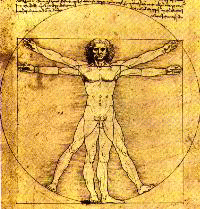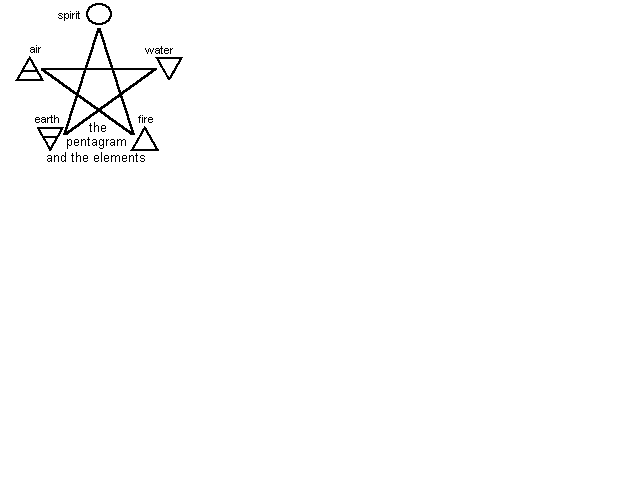Thanks to Lionel Pepper for the research
The number 5 has always been regarded as mystical and magical, yet in essence "human".
We have five fingers and five toes on each extremity.
The five common senses of sight, hearing, smell, touch and taste.
Humans perceive five major stages in our lives; birth, adolescence, union of male and female, parenthood, and death.
The number 5 is associated with Mars. It signifies severity, conflict and harmony through conflict.
In Christianity, Christ had five wounds on the cross.
There are five pillars of the Muslim faith and five daily times of prayer.
The medieval knight had five virtues - generosity, courtesy, chastity, chivalry and piety as symbolized in the pentagram device on the shield of Sir Gawain.
The number five is prime.

The upright pentagram bears resemblence to the shape of a human with outstretched arms and legs. We can juxtapose a human figure on a pentagram with head and four limbs at the points. This is man in microcosm, symbolizing our place in the Macrocosm or universe.
The concept of the microcosmic world of man corresponding to the macrocosm,
the greater universe of spirit and elemental matter, became part of traditional
western occult teaching, as it had long been in Eastern philosophies. This
is a Da Vinci drawing of this concept.
The pentagram later became symbolic of the relationship of the head to
the four limbs, and so from this, of the concentrated essence of anything
(or the spirit) to the traditional elements of matter - Earth, Water, Air
and Fire.
The pentagram has long been believed to be a potent protection against evil, a symbol that shields the wearer and the home.
It has five spiked wards and a womb-shaped defensive, protective pentagon at the center.

There are five elements in the pagan world, four that are matter (Earth, Air, Fire, Water), and Spirit. These are arranged around the points.
The elements are placed in order of density - Spirit, Fire, Air, Water, Earth. Earth and Fire are basal, fixed. Air and Water are free, flowing.
In ritual, the pentagram is sometimes drawn in the air either using the hand or a ritual knife known as an athame. Drawn one way it is used for invoking, the opposite for banishing.
Single point upward signifies the spirit ruling matter. It is a symbol of rightness. With two points up and one (spirit) downward, is signifies subservience, the emphasis is on the carnal nature of man.
Open Pentagram
A pentagram may be open, without a surrounding circle. This is the active form symbolizing an outgoing of oneself, prepared for conflict, aware, active. As a pagan religious symbol, the open pentagram represents an open, active approach.
Closed Pentagram
A circle around a pentagram contains and protects. The circle symbolizes eternity and infinity, the cycles of life and nature. The circled pentagram is the passive form implying spiritual containment of the magic circle, and the individual nature of the pagan religious path.
Inverted Pentagram
The implication of inversion of a pentagram is the spirit is subservient to matter, man subservient to his carnal desires. It has come to represent the dark side and is considered a symbol of evil by Christians. In the 1940s Gerald Gardner adopted the inverted pentagram as a symbol of second degree initiation in the newly emergent, neo-pagan rituals in what was to become wicca. It represents the need of the witch to learn to face the darkness within so it will not rise to take control. First degree uses a downward pointing triangle, third degree uses one-point up pentagram together with an upright triangle.
History of the Pentagram
The pentagram has been used throughout history.
The earliest known use dates to around the Uruk period around 3500 BCE at Ur of the Chaldees in Mesopotamia. It was found on potsherds with other symbols.
The pentagram was a symbol of imperial power in later periods of Mesopotamian art. Power extended out to "the four corners of the world".
To the Hebrews, the symbol was linked to Truth and to the five bolls of the Pentateuch.
In Ancient Greece, it was called Pentalpha, as the pentagram is composed of 5 "A" shapes..
The geometry and metaphysical associations of the pentagram were explored by the Pythagoreans who considered it and emblem of perfection.
To the Gnostics, it was the "blazing star" and along with the crescent moon was a symbol relating to the magic and mystery of the night sky.
It was a symbol of Godhead for the Druids.
The Celts associated it with the underground goddess Morrigan.
Early Christians attributed the pentagram to the five wounds of Christ and from then until medieval times, it slowly disappeared. Before the Inquisition there were no evil associations with the pentagram.
The Emperor Constantine I used the pentagram, along with the chi-rho (a symbolic form of cross) in his seal and amulet.
The annual church feast of Epiphany that celebrates the visit of the three Magi to the infant Jesus, had the pentagram as its symbol. It is now changed to a regular 5 point star in reaction to neo-pagan use of the pentagram.
In medieval times it was a symbol of truth and protection against evil. It was used as an amulet of personal protection and to guard windows and doors.
One point up symbolized summer, two points up it was a sign for winter.
The Knights Templar used the pentagram shape in the placement of chapels and shrines in the Rennes de Chatres in France. During the Inquisition many lies were spread. The pentagram was seen to symbolize a goat's head or the devil in the form known as Baphomet, whom the Inquisition accused the Templars of worshiping.
The healers of the time took advantage of herbs brought from the East, as did murders who wished to gain power. Prominent deaths by poisoning caused the Dominicans of the Inquisition to move their attention from the Christian heretics to the pagan witches, the ones still following the Old Religion, because they knew of the uses of herbs. The church condemned as evil all who used the pentagram, and condemned the symbol itself.
Pagan horned gods such as Pan became equated with the devil and the pentagram, which then was called The Witch's Foot.
In modern Wicca the pentagram can also be inscribed on the alter pentacle, points symbolizing the three aspect of the Goddess plus two aspect of the God.
The pentagram use in modern neo-paganism as a group symbol is as important as the cross has been in the history of Christianity.
[Bath and Beauty Room] [Kitchen] [Manor-House Society] [Links]
[Recommended Reading] [Webrings] [Awards] [Text Only Site]
[Sign or View Guest Book]